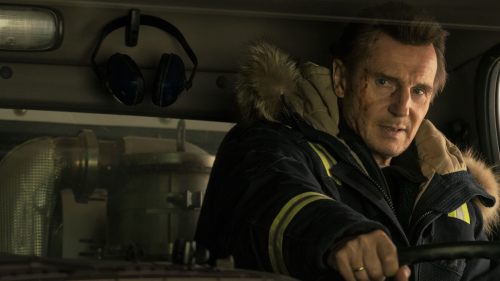COLD PURSUIT And Why Directors Remake Their Own Movies
Cold Pursuit is out this week. Get your tickets here!
Lost amongst the roiling controversy over Liam Neeson’s press junket comments regarding a racist revenge fantasy is that his new film, Cold Pursuit, is the rare American remake of a foreign language film that’s helmed by its original director. Hans Petter Moland came to the States to adapt his 2014 black comedy In Order of Disappearance and made something so close to the source as to be mildly creepy. From the incessant close-ups of a snow plow barreling into frame to the establishing shots of cars driving down a lone road into a major city, Cold Pursuit can occasionally feel redundant. What makes an artist want to copy themselves, to essentially relive weeks, months, or years of their own lives all over again? In the case of Cold Pursuit, even if the film is eerie in its resemblance to its source, the very act of moving the story to America fundamentally changes the themes at play. It’s the same movie, but it’s also not at all.
One might consider the English-language remake to be a craven cash grab. The blueprint for a successful piece of art is there, so in theory, these films should be overwhelming successes. Unfortunately, what looks and sounds good in a language other than English doesn’t always translate. Canadian director Ken Scott adapted his French-language film Starbuck into the 2011 Vince Vaughn vehicle Delivery Man, about a sperm donor who fathered 533 children. It’s a depressing story if you take even a single second to ponder the situation, (you have 533 children you can never meet) and yet Delivery Man was meant to be a heartwarming comedy. Sometimes, edgy ideas work better from the detached distance that’s afforded the viewer when the movie is in a different language.
Michael Haneke’s infamous American remake of Funny Games was painstakingly true to the original, to the point that Haneke refused to make any changes or alterations to his initial vision. An English version of a successful foreign-language film should hypothetically encourage new audiences to sample a work they’d otherwise ignore. But with Funny Games—a purposefully transgressive, non-commercial work—the audience for such a movie already saw it. For the discerning moviegoer, seeing the English adaptation of a respected art house film is the equivalent of watching a foreign film with a dubbed audio track.
Haneke’s eccentric insistence on making an identical film is a bit of an outlier. More often than not, the director redoing their own movie (if it's a foreign language translation or not) wants to make an improvement. Alfred Hitchcock remade The Man Who Knew Too Much in 1956 because he wasn’t pleased with the results the first time around, in 1934. Yasujiro Ozu remade A Story of Floating Weeds in 1959 because he wanted to add sound to a silent film. Michael Mann remade his failed TV pilot L.A. Takedown into the theatrical release Heat, because he wanted to add more character beats.
Hans Petter Moland is somewhere in the middle of these two approaches. Cold Pursuit retains the dour Scandinavian aesthetic and the ultra-violence of In Order of Disappearance. The absurdist sense of humor remains, down to reproductions of entire sight gags. But Cold Pursuit inverts a crucial aspect of In Order of Disappearance. In the original, the rival gang is comprised of Serbians, allowing the movie to comment on the increasing number of Eastern European immigrants coming to previously homogeneous nations like Norway and the xenophobia that comes attached to that migration. It’s not a politically minded film, but it does derive much of its conflict from real-world concerns. The Norwegian gang led by The Count is elitist, cold, and bourgeois—a comment on Norway’s rising upper class. The Serbs are earthy, spiritual, and fiercely loyal. When Stellan Skarsgaard’s Niels Dickman starts killing The Count’s foot soldiers in retaliation for them murdering his son, the fragile peace between the Norwegians and the Serbs collapses, because there was never trust there to begin with.
By moving Cold Pursuit’s actions to Colorado, screenwriter Frank Baldwin had to reimagine that thematic material. The solution is to replace the Serbian gangsters with a Native American crew. It’s still minority group hounded by intolerance, but now they’re the ones who were here first. The Norwegians in the original were suspicious of the Serbs destroying their culture. In Cold Pursuit, the Native Americans have already had their culture ruined by European settlers hundreds of years ago. These are parallel points that seem like opposites at first, but because the history of America is far different than the history of Norway, it’s really the same idea communicated through different means. Both films have something powerful to say about xenophobia, fear of the other, and provincial, small-town values.
Cold Pursuit wisely harnesses the issues present within the origin story of this entire country. If it’s necessary to remake your own film, it’s crucial that the director and the writer have the distance required to reimagine the story for a new audience. Of course, that can be a tall order for creative people who have lived with a story for years. Why would Michael Haneke change a frame of Funny Games in order to appeal to America? The truly personal works of art are as much a product of their culture of origin as they are visions from the mind of their creators. Could Battleship Potemkin have been made anywhere but the Soviet Union? Would any other country besides the United States have produced such a brazen piece of racist propaganda as Birth of a Nation? Cold Pursuit works because it deftly melds the grim Norwegian aesthetic with elements that could only be found here. That, alone, makes it a worthwhile companion piece to its forebearer.



